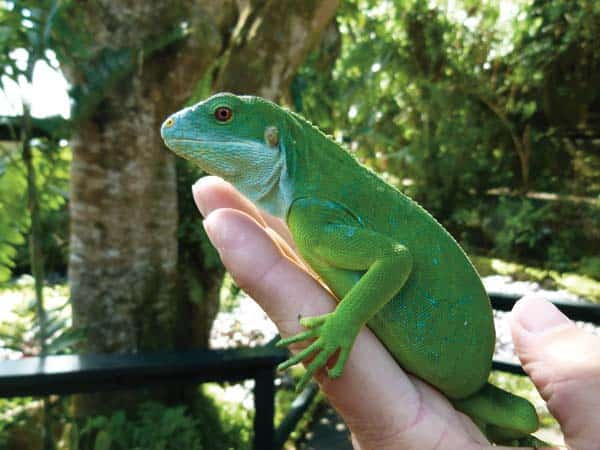Take a journey to Yadua Taba, a Fiji island sanctuary of the critically endangered Brachylophus vitiensis.
Cannibals, head shrinking and Captain Bly are just three elements that help paint Fiji’s colorful past. The 300-plus islands that comprise Fiji are now known more for surfing, scuba diving, snorkeling and romance. The Fijian people welcome tourists with the native greeting of bula (hello), and visitors from around the world come to enjoy the coconut palm-lined beaches, romantic cruises and the laid-back life style. For me, however, there was a different reason to visit Fiji: the Fiji crested iguana!
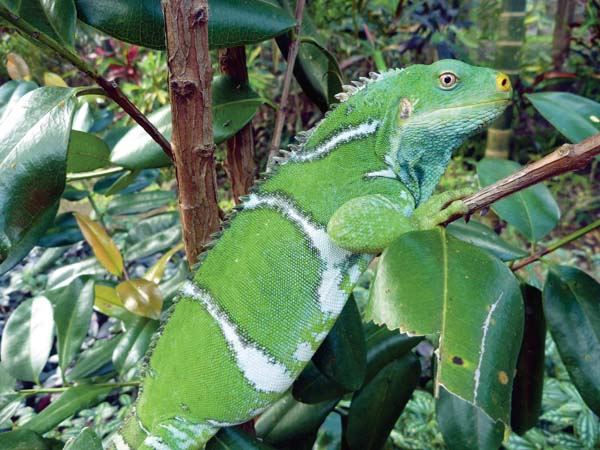
Jerry Fife
Although all three iguana species endemic to the Fiji islands–the Fiji crested iguana, the Lau banded iguana, and the Fiji banded iguana–are classified as Endangered to Critically endangered on the IUCN Red List and listed on Appendix I of CITES, the crested iguana is the most imperiled.
There are three iguana species endemic to the Fiji Islands: the Fiji crested iguana (Brachylophus vitiensis), the Lau banded iguana (B. fasciatus) and the Fiji banded iguana (B. bulabula). The Fiji crested iguana is the largest and most colorful of the three, and while all of them are classified as Critically Endangered on the IUCN Red List and listed on Appendix I of CITES (Convention on International Trade in Endangered Species), it also is the most imperiled.
The Fiji crested iguana was discovered in 1979 by Dr. John Gibbons, and it is restricted to the drier, northwestern islands of Fiji. It was once widely distributed throughout the Mamanuca Islands, Monuriki, the Yasawa Islands and a small island called Yadua Taba. Its numbers have declined drastically, however, and it is no longer found on many of the islands due to habitat destruction, introduced goats that graze on native trees, and the fact that it is easy prey for feral cats, dogs and mongoose.
The Fiji National Trust recognized these threats and it had the uninhabited island of Yadua Taba cleared of goats and declared a Fiji crested iguana sanctuary. This was the place I wanted to go.
Yadua Taba in Fiji
Visiting Yadua Taba required an approval process, and my first step was to contact the Fiji National Trust. A permit would be mandatory, so I completed the extensive permit application and mailed it, along with the application fee and a copy of my iguana book, to the National Trust.
That was only the beginning, and it took approximately a year and numerous emails to coordinate the trip. Finally, in June 2011, I was all set to go. Then, to my horror, everything almost fell apart thanks to a cruise ship that made an unauthorized stop at Yadua Taba the week before I was set to leave. Luckily, despite this unexpected turn of events, I was relieved to find out I would still be permitted to visit the sanctuary, along with several members of the National Trust, who would be assessing any damage resulting from the unauthorized cruise ship stop.
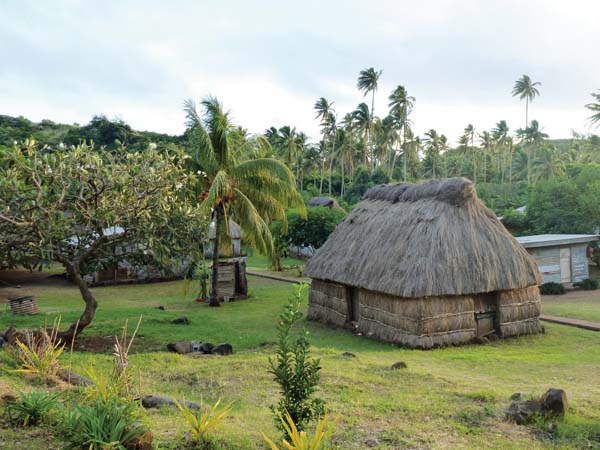
The village of Denimanu on the island of Yadua, which is next to Yadua Taba. The author had to present the chief with the traditional gift of kava roots and obtain permission from the chief to visit Yadua Taba.
We set out. The original plan was to camp on Yadua Taba for two nights, but due to rough seas we were unable to reach the island. Instead, drenched from the rough boat ride, we landed on the neighboring island of Yadua, where we would spend the first night in the village of Denimanu. Upon landing, one of the first orders of business was to present the village chief with a traditional offering of kava roots. We also asked for and received his permission to visit the iguana sanctuary on Yadua Taba. A traditional meal followed the kava ceremony, and my anticipation mounted at the prospect of finally being able to visit the iguana sanctuary the next day, weather permitting.
Exploring the Iguana Sanctuary at Yadua Taba
Fortunately, the sea was calm the next morning, and we set sail for Yadua Taba. Upon arrival, we set up tents and immediately set out to search for Fiji crested iguanas.
The first iguana was spotted high up in an ivi tree above our campsite, where only its silhouette was visible through the thick, round leaves. There are reportedly several thousand iguanas on the island, and the heavy vegetation provides great camouflage and protection for them. The Pacific boa (Candoia bibroni), which preys on lizards elsewhere in Fiji, is not found on Yadua Taba, so the only natural predators of the iguanas are birds, such as the Fiji hawk.
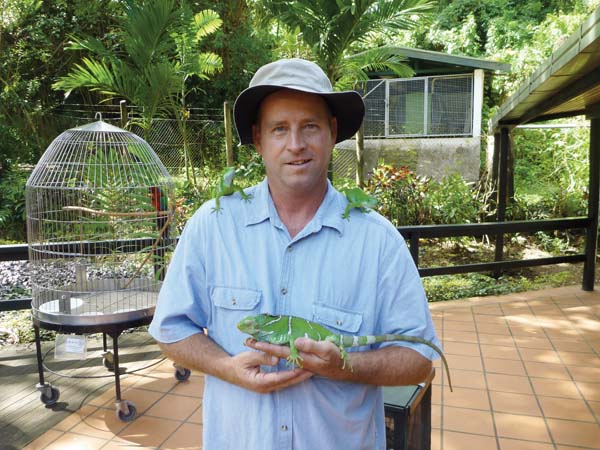
The author holds a Fiji crested iguana in his hands, and has a pair of banded iguanas on his shoulders, at the Kula Eco Park in Sigatoka on the main island of Viti Levu.
We hiked inland, under the canopy, and within a few minutes found another iguana relaxing on a branch about 15 feet off the ground. Although I had held a Fiji crested iguana at Kula Eco Park (located on Viti Levu, the largest island in Fiji), seeing my first Brachylophus vitiensis in the wild was an incredible feeling. I felt honored, too, because I think I may be the only American citizen who has been permitted to camp on Yadua Taba. I knew I was seeing and experiencing something only a handful of people outside of Fiji have ever experienced, and that moment of getting a good look at that iguana in its natural habitat lived up to all expectations. Fiji crested iguanas are truly beautiful lizards.
While walking back to camp, the ranger (there is one, who regularly patrols the island) pointed out where he had observed an iguana laying eggs. Nests are dug on the forest floor in shaded areas, and a clutch of two to six eggs is laid, generally during the rainy season between the months of February and April. The oval eggs are approximately 1.25 inches long and take more than six months to hatch. There are no subspecies recognized, though Fiji crested iguanas on other islands do exhibit some distinguishing features, including differences in pattern and size (a smaller-than-normal iguana was discovered on another northern Fiji island just weeks before my visit).
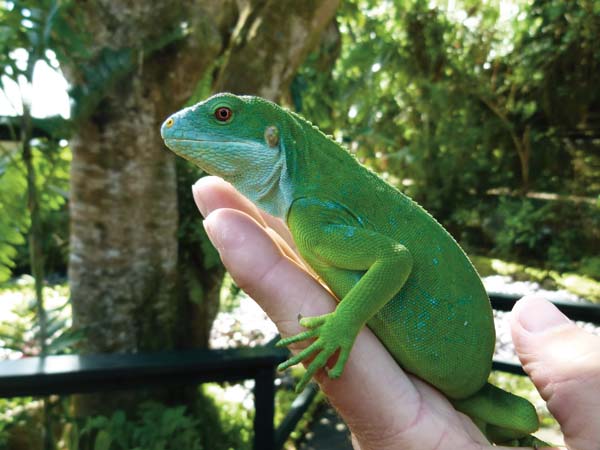
Jerry Fife
The female Fiji banded iguana (B. bulbula) is a solid green and lacks the white banding of males
The National Trust staff invited me along to assess the damage caused by the unauthorized cruise ship visitors from the previous week. We walked along the beach until we arrived at their landing site. Fortunately, the only evidence that they had been there was the remains of some coconuts that had been eaten. We could see the nearby island of Yadua, and it was scary to think that this much larger island, one that was so close to Yadua Taba, was no longer home to any iguanas.
We found several iguanas along the rocks and among vegetation next to the beach. This was when I got to hold my first wild Fiji crested iguana. It was amazing to discover how calm even a wild specimen was, as it exerted only a minimal effort at escape. Both male and female Fiji crested iguanas share the same color patterns. When they are calm, they are predominantly bright green with white bands that are often outlined in black. They have tan eyes and bright yellow nostrils, and some have a bit of yellow on their lips. The dewlap is turquoise and both sexes have a crest down their backs. Adults grow to about 30 inches from the snout to the tip of the tail. Males can be distinguished by the broader head, femoral pores and hemipenal bulge at the base of the tail.
I continued exploring the island and soon learned that a Fiji crested iguanas natural defense is similar to that of a chameleon. It will try to blend in with its surroundings and will slowly move to the opposite side of a branch so only its feet are visible. When confronted it will stand up tall, flatten its body and gape to look large and fierce. While an agitated iguana may bite, such displays are mostly for show and I found I could easily slide my hand under them to pick them up. Flight seems to be the absolutely last choice for defense and perhaps this is why these iguanas are so susceptible to unnatural predators, such as cats and dogs.
Another chameleon-like characteristic of B. vitiensis is its ability to change colors. When threatened or stressed, it can turn from its normal bright green to practically black. They seemed to turn darker the longer a perceived threat persisted. While this was interesting to observe, it did make it difficult to get photos of the iguanas displaying their vivid green coloration.
During my short stay on Yadua Taba, we found more than 30 crested iguanas. We found them throughout the island, from vegetation bordering the beach to the top of the highest peak. In addition to the iguanas, Yadua Taba is home to a number of other reptile species, including a variety of skinks, the hawksbill sea turtle and the sea krait. When we first landed, we found tracks and the nesting site of a hawksbill that had come ashore to lay eggs the previous night. Several species of sea turtles are found throughout Fiji, but the hawksbill is the only one reported to nest on Yadua Taba. We also found one small, black and white banded sea krait in a tidal pool.
I was left mostly on my own, observing and photographing iguanas. I was also happy to learn that the snorkeling off Yadua Taba was exceptional. Not only is the island protected, but the surrounding waters are, too, with no fishing allowed. The fish and coral were spectacular. In addition to the vast array of corals, sea slugs and colorful fish, I also found a moray eel peering out from its hole in the coral reef. I was told that manta rays could be found in the deeper waters off the island, though I didn’t see any.
The small volcanic island of Yadua Taba is just over 4 square miles. It is classified as tropical dry forest, though it receives about 80 inches of rain annually, mostly during the wet season from February to April. Coconut palms line the beaches, giving way to other trees, vines and tropical vegetation. The purple fruit of Vavaea amicorum is an important part of the crested iguana’s diet in the wild, along with Hibiscus tiliaceus. The canopy on Yadua Taba is considered low, but in places it is 30 feet tall. I decided to hike to the highest point on the island and the top of a 300-foot peak. I soon found, however, that hiking to the top was extremely difficult due to the steep terrain, loose soil and a thick patch of non-native lantana that I came upon. The National Trust has made efforts to remove invasive vegetation, but this particular patch of lantana was in a challenging location from which it would be extremely difficult to remove.
After I navigated my way around the lantana, and as I continued upward, I was able to photograph four different skink species: a barred tree skink (Emoia trossula), a brown-tailed copper-striped skink (E. cyanura), a green tree skink (E. concolor) and a blue-tailed copper-striped skink (E. impar). Finally, I crested the peak. The vegetation at the top was as thick as that of the rest of the island, and I was pleased to find a Fiji crested iguana in a tree at this highest elevation. This meant that the species was well distributed across the island, and not just at the lower elevations.
The Banded Iguanas of Fiji
As previously mentioned, the other two iguanas endemic to Fiji are the two species of banded iguanas: the Lau banded iguana (B. fasciatus) and the Fiji banded iguana (B. bulabula). The Lau banded iguana is found in the Lau group of islands, east of the two largest Fiji islands, and Tonga. The Fiji banded iguana is found in wet forest on several islands in central Fiji, including Ovaluau, Kadavu and others. The two species of banded iguana are similar in appearance. They were even classified as the same species, B. fasciatus, until 2008. Unlike the Fiji crested iguana, banded iguanas can be found in U.S. zoos, where most are labeled on zoo displays as Brachylophus fasciatus, even though they are in fact the more recently described B. bulabula.
The two banded iguanas are slightly smaller than the Fiji crested iguana: the Fiji banded iguana reaches a total length of little more than 18 inches from the snout to the tip of the tail; the Lau banded iguana is about 3 or 4 inches shorter.
Males are emerald green with prominent light bluish or white bands. Females of both species lack the bands and are solid green, though they may exhibit some lighter spots. Both banded iguanas have yellow nostrils and may have some yellow coloration on their lips, though the Lau banded iguana’s nasal scale is more elongate and has a reduced yellow coloration. It also has an orange-red iris, while the Fiji banded iguana’s iris is red. Male B. fasciatus lack a nuchal stripe and have nuchal spotting instead, and this species also has a smaller parietal eye and shorter dorsal crest than B. bulabula.
Both banded iguanas can reach sexual maturity in less than 18 months. One to seven eggs are laid in a clutch, which take four to six months to hatch at a temperature between 84 and 86 degrees Fahrenheit. Unlike the Fiji crested iguana, which may lay eggs only every two years in the wild, captive banded iguanas have been known to double clutch. Breeding groups may include one male and multiple females, and males will fight to defend their territories (the same is true for the Fiji crested iguana).
Like the Fiji crested iguana, the banded iguanas are arboreal and feed on various vegetation, fruit and flowers. Hibiscus leaves and flowers are common for both wild and captive banded iguana diets, along with mango, papaya, kiwi, berries, melons and various greens.
Fiji Crested Iguana Populations
Although I feel priviliged to be one of the few people who has had the opportunity to see Fiji crested iguanas in the wild, I remain concerned for the future of the species. It has been estimated that 99 percent of the world’s population of Fiji crested iguanas is on the small sanctuary of Yadua Taba. One tsunami could wipe out much of the island, or create a land bridge to Yadua which could introduce rats or mongoose to the sanctuary. Invasive plants could threaten the native plants that the iguanas rely upon for food and shelter. Any invasive animal or virus could be devestating to the iguana population there.
The Fiji National Trust has done much to protect the iguana by establishing Yadua Taba as a sanctuary and clearing the island of goats, as well as educating people about the iguana. However, it has few resources to implement its full management plan for this species. Captive breeding could help, but complicating matters are laws protecting the iguanas that currently prevent captive-breeding programs outside of Fiji.
The Kula Eco Park is one of the few facilities breeding Fiji crested iguanas. It is a privately owned facility, though, and if it were ever closed down, would the National Trust have the resources to continue captive breeding of the iguana or would all captive breeding of the species cease? There are insufficent bloodlines outside of Fiji to sustain captive breeding, yet the Fiji government has been hesitant to allow export of their national treasure to international zoos or breeding facilities. If a reintroduction plan is needed to help the Fiji crested iguana survive in the wild, will there be sufficient founder stock and captive-breeding facilities to facilitate such a plan?
The two banded iguanas are not as critically threatened as the Fiji crested iguana. There are a few islands where they are common, and populations are stable. They are protected and classified as CITES I, and they are also on the U.S. Endangered Species list. They are being bred by zoos in the U.S., as well as by private breeders in Europe. I am not aware of any permits, however, that have been approved by the U.S. Fish and Wildlife Service that allow any private individuals in the U.S. to keep any of the Fiji iguana species.
If you want to see live Fiji crested iguanas in the flesh, you will have to travel to Fiji or Australia (in addition to the Kula Eco Park, several Australian zoos maintain the species). There are none in U.S. zoos or private collections. Much like the mystical past of Fiji, the Fiji crested iguana has had a history intertwined with pirates and smugglers. Attempts have been made to smuggle the iguana out of Fiji in every imaginable way, including one smuggler who tried hiding some in a hollow leg! Hopefully, the conservation efforts of the Fiji National Trust and the breeding efforts of the Kula Eco Park will ensure that the Fiji crested iguana will be protected for future generations. If you are interested in helping to protect this magnificent iguana, please consider making a donation to the National Trust by visiting the website at nationaltrust.org.fj. REPTILES
Jerry Fife lives in Phoenix, Ariz. He has written various articles and books, including the book, Iguanas: A Pictorial Guide to the Iguanas of the World and Their Care in Captivity. He breeds several iguana species and has traveled to see every genus in the Iguanidae family in nature. He can be contacted through his website at fifereptiles.com.

